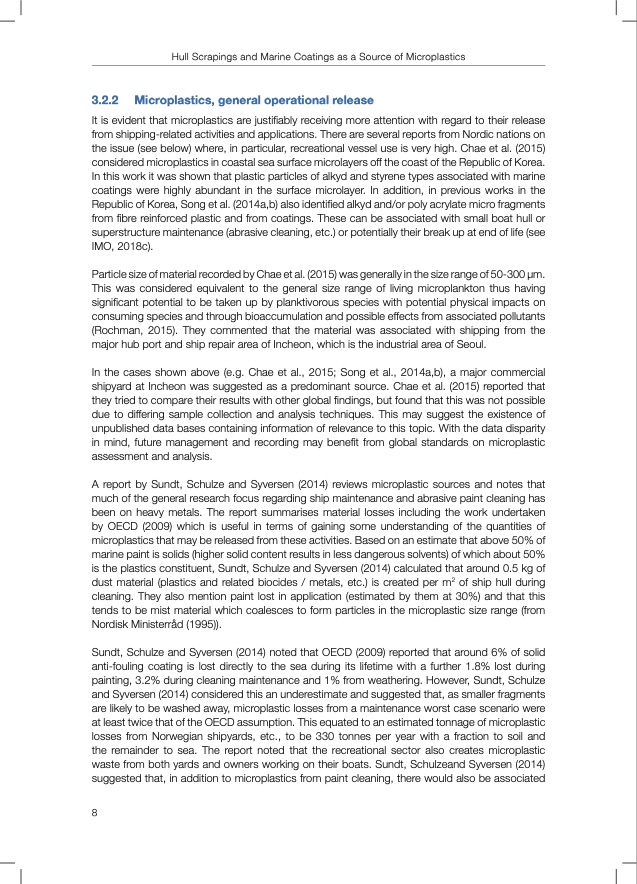
PDF Publication Title:
Text from PDF Page: 017
Hull Scrapings and Marine Coatings as a Source of Microplastics 3.2.2 Microplastics, general operational release It is evident that microplastics are justifiably receiving more attention with regard to their release from shipping-related activities and applications. There are several reports from Nordic nations on the issue (see below) where, in particular, recreational vessel use is very high. Chae et al. (2015) considered microplastics in coastal sea surface microlayers off the coast of the Republic of Korea. In this work it was shown that plastic particles of alkyd and styrene types associated with marine coatings were highly abundant in the surface microlayer. In addition, in previous works in the Republic of Korea, Song et al. (2014a,b) also identified alkyd and/or poly acrylate micro fragments from fibre reinforced plastic and from coatings. These can be associated with small boat hull or superstructure maintenance (abrasive cleaning, etc.) or potentially their break up at end of life (see IMO, 2018c). Particle size of material recorded by Chae et al. (2015) was generally in the size range of 50-300 μm. This was considered equivalent to the general size range of living microplankton thus having significant potential to be taken up by planktivorous species with potential physical impacts on consuming species and through bioaccumulation and possible effects from associated pollutants (Rochman, 2015). They commented that the material was associated with shipping from the major hub port and ship repair area of Incheon, which is the industrial area of Seoul. In the cases shown above (e.g. Chae et al., 2015; Song et al., 2014a,b), a major commercial shipyard at Incheon was suggested as a predominant source. Chae et al. (2015) reported that they tried to compare their results with other global findings, but found that this was not possible due to differing sample collection and analysis techniques. This may suggest the existence of unpublished data bases containing information of relevance to this topic. With the data disparity in mind, future management and recording may benefit from global standards on microplastic assessment and analysis. A report by Sundt, Schulze and Syversen (2014) reviews microplastic sources and notes that much of the general research focus regarding ship maintenance and abrasive paint cleaning has been on heavy metals. The report summarises material losses including the work undertaken by OECD (2009) which is useful in terms of gaining some understanding of the quantities of microplastics that may be released from these activities. Based on an estimate that above 50% of marine paint is solids (higher solid content results in less dangerous solvents) of which about 50% is the plastics constituent, Sundt, Schulze and Syversen (2014) calculated that around 0.5 kg of dust material (plastics and related biocides / metals, etc.) is created per m2 of ship hull during cleaning. They also mention paint lost in application (estimated by them at 30%) and that this tends to be mist material which coalesces to form particles in the microplastic size range (from Nordisk Ministerråd (1995)). Sundt, Schulze and Syversen (2014) noted that OECD (2009) reported that around 6% of solid anti-fouling coating is lost directly to the sea during its lifetime with a further 1.8% lost during painting, 3.2% during cleaning maintenance and 1% from weathering. However, Sundt, Schulze and Syversen (2014) considered this an underestimate and suggested that, as smaller fragments are likely to be washed away, microplastic losses from a maintenance worst case scenario were at least twice that of the OECD assumption. This equated to an estimated tonnage of microplastic losses from Norwegian shipyards, etc., to be 330 tonnes per year with a fraction to soil and the remainder to sea. The report noted that the recreational sector also creates microplastic waste from both yards and owners working on their boats. Sundt, Schulzeand Syversen (2014) suggested that, in addition to microplastics from paint cleaning, there would also be associated 8PDF Image | HULL SCRAPINGS AND MARINE COATINGS AS A SOURCE OF MICROPLASTICS

PDF Search Title:
HULL SCRAPINGS AND MARINE COATINGS AS A SOURCE OF MICROPLASTICSOriginal File Name Searched:
Hull-Scrapings-report.pdfDIY PDF Search: Google It | Yahoo | Bing
Development of a solar powered Electric Ship The Electricship website originally started off as a project to develop a comprehensive renewable, affordable, modular electric ship... More Info
Modular Boat Hull Composite The case for a unsinkable, modular composite hybrid boat hull... More Info
MS Burgenstock Hybrid Electric Catamaran Lake Lucerne Unique shuttle servicing Lucerne to the Burgenstock Resort... More Info
Ground Power Unit GPU Powered by Lithium Ion Batteries The goal of the Ground Power Unit is to provide a readily accessible, modular, ready-to-power solution for remote power... More Info
| CONTACT TEL: 608-238-6001 Email: greg@electricship.com | RSS | AMP |